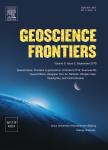The significance of U-Pb zircon ages in zoned plutons:the case of the Flamenco pluton, Coastal Range batholith, northern Chile
The significance of U-Pb zircon ages in zoned plutons:the case of the Flamenco pluton, Coastal Range batholith, northern Chile作者机构:Departamento de Geología Universidad de Atacama Departamento de Ciencias de la Tierra Universidad de Huelva Institut für Geologie TU Bergakademie Freiberg High Resolution Geochronological Laboratory University of S?o Paulo
出 版 物:《Geoscience Frontiers》 (地学前缘(英文版))
年 卷 期:2019年第10卷第3期
页 面:1073-1099页
核心收录:
学科分类:07[理学] 0708[理学-地球物理学] 0704[理学-天文学]
基 金:funded with FONDECYT Project No. 11140722 of CONICYT the fund support of DIUDA 2013-22268 and DIUDA 201422273 projects
主 题:Zircon U-Pb geochronology Zoned plutons Andean magmatic arc Sequential emplacement Individual and statistical zircon ages
摘 要:Compositionally zoned plutons, both layered and concentrically arranged, provide granitic exposures where the mechanisms and timing of the magmatic emplacement processes can be studied. The importance of in-situ geochemical differentiation and the magma replenishment rates are revealed by geochemistry and field relations, together with the increasingly accurate U-Pb geochronology, which has promoted the knowledge about the pluton incremental assembly theories.The Flamenco pluton, located in the Coastal Range of northern Chile, is part of the Upper Triassic to Early Cretaceous Andean intrusives formed in the western active margin of South America, and present a normal zoned structure with mafic magmatic facies(mostly gabbros and Qtz-diorites) close to the contacts with the host metasediments, and tonalites, granodiorites and granites in the inner areas. A combined study of the field relations, geochemistry and zircon geochronology of the magmatic facies was applied to determine the emplacement sequence of the Flamenco pluton, revealing three distinguishable domains separated by metasedimentary septa. The SW area is constituted by mostly homogeneous leucocratic granodiorites that yielded an age of 213 Ma as the best estimation for their emplacement age. Distinctive geochemical characteristics, such as the absence of an Eu anomaly, the depletion in HREE, or the highest Sr, Sr/Y and Ce/Yb values among the granodioritic facies of the pluton,involve lower T and/or higher P conditions at the magmatic source according to experimental studies.These conditions were established during an early stage of the Andean magmatic arc building that is firstly defined here as Upper Triassic. The NW and E domains of the pluton were sequentially emplaced between 194 Ma and 186 Ma and both the field relations and the detailed geochronological results suggest that the mafic facies intruded latter in the emplacement sequence. To the NW, Qtz-dioritic and gabbroic externally emplaced pulses gave a younger crystallization age of 186.3 ± 1.8 Ma, and promoted the granoblastic textures and metamorphic zircon overgrowths that characterize the granodiorites located in the contact with the intermediate and felsic inner magmas, which yielded a best estimation of their emplacement age of 192 士 1.5 Ma. On the other hand, in the eastern domain, magma-magma relations are observed between gabbros and previously intruded tonalites and granodiorites. Both the mafic and intermediate facies show two main subgroups of ages that yielded 194.7 土 1.5 Ma to188.3 ± 2.1 Ma and 193.1 ± 2.2 Ma to 185.5 ± 1.4 Ma respectively. These differences are related to the variations in the magmatic addition rates, which may extend the super-solidus conditions in the eastern domain of the magmatic reservoir as is confirmed by the wider age ranges yielded by these magmatic facies. Zircon overgrowths in the host rocks yield similar ages(around 220 Ma and 205 Ma) than the oldest results obtained in the intrusive facies, indicating that metamorphism correlates with the initial stages of plutonic emplacement.Geochronological results differ between 9 Myr and 41 Myr in the eight studied samples for noninherited ages and gave very close mean ages(within analytical uncertainty) for all the intrusive units. However, we examine other characteristics such as zircon morphology, internal structure,geochemistry and statistical data to assess if the scattering of the geochronological data may be related to the different processes involved in the construction of the Flamenco pluton. We concluded that this detailed study of U-Pb zircon ages, including individual and significative groups of analyses, is useful to determine accurately the emplacement sequence and the genetic relation between the intrusive units,together with the evidences depicted by the geochemistry and field relations.



